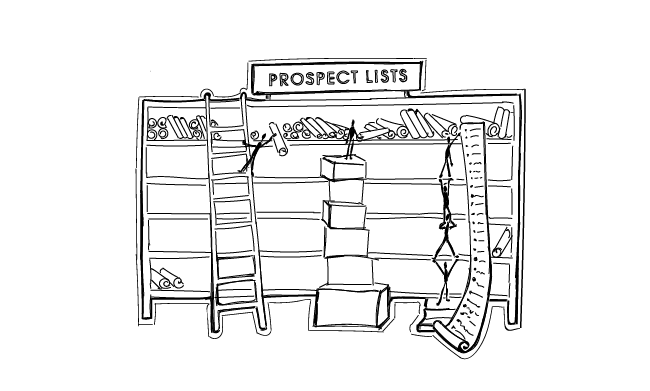Business-to-business sales is always a challenge but there are some shortcuts to success. I’ve put together some tips for boosting your chances with some simple but effective sales tactics and other improvements you can make to your cold outreach to decision-makers. From big-idea sales strategy to small-scale changes in the way you craft your messaging and approach potential customers, use this list to up your B2B sales prospecting game today.
B2B prospecting is tough, but there are ways to make it easier
Creating and cultivating cold sales leads is a tough task, as getting rejected and ignored are standard. Customer loyalty seems like a mirage and your target customers are hard to reach. When you do get through your hard work is often met with silence on the other end. Making progress along the conversion path takes time, patience and persistence.
B2B customers are much more marketing-savvy than B2C customers, too. They know much of your marketing playbook and they are far less likely to respond to techniques that may work when dealing with the public. They want to be an audience of one and doing that at scale is a challenge.
But B2B prospecting makes the wheels of business turn, no matter how hard it is, even for sales professionals. Without a skilled sales team, using effective prospecting techniques and a proven sales model, the sales pipeline will soon run dry and you know what happens after that.
Fortunately, there are some strategies, guidelines and proven tricks that will help you reach your sales goals. I’ve gathered some of the most important ones below. Use them to get more quality leads, change those leads into potential buyers and focus on closing deals.
What is B2B prospecting?
First, a quick clarification of our terms.
For our purposes, I’m going to use the broad understanding of B2B sales prospecting, including everything in the process of identifying potential customers for your business, building relationships by reaching out to them and cultivating that contact to the point where a deal is made.
Each of these stages — identifying possible customers based on their needs, reaching out to the right people & starting conversations, taking them through the buying journey — has its own unique demands, challenges and success metrics, which are usually diffent than those in business to consumer sales.
B2B prospecting typically values quality over quantity but there are exceptions. The early stage of separating businesses that are in the market for your product or service versus those that are not strongly influences the direction of the entire sales process. The better you are choosing the right targets, the more efficient your work will be.
B2B prospecting techniques checklist
Use this checklist to get useful tips and ideas for each of the stages in B2B prospecting.
Use your buyer personas to target the right audience
It sounds like an obvious place to start but the pressure of generating good leads can sometimes lead to compromises here. This is a mistake because of the wasted time on outreach that will go nowhere. Aligning sales tactics to match your target audience is a must.
There is no point in padding your statistics by casting a wider net that will inevitably include companies with no real need for what you’re selling. Those impressive early numbers are guaranteed to turn into embarrassing numbers later when they all result in dead ends. Marketing teams work by trying to talk to the right people, right from the start.
If you can maintain a high retention rate when making the transition from MQL to SQL, you’re halfway to success.
Work on your ICP and be strict about making sure a potential prospect ticks the right boxes before you start investing your time and effort.
Segment & prioritize your prospects
This is about more than dividing prospects based on sales experience, where they are in the customer journey or how much contact you’ve already had. It’s about recognizing when they’re ready for a move.
Some prospects will be “warmer” than others, earlier than others. Those are the prospects that deserve your time and attention now. When a window of opportunity opens, the clock starts ticking and segmenting prospects into different categories of priority just makes sense.
Still, always be sensitive to changes in the “temperature” of all prospects on your radar. A regular review of the current status of all prospects is a good way to keep your priorities straight and focus on the contacts that are ready to move forward. The fact is that purchasing decisions just take longer in some businesses and there’s little you can do to speed up that decision-making process.
Remember that there’s nothing wrong with moving a contact to the “Cold” column if the progress just isn’t there.
Bottom line — know where to focus your efforts and always be on the lookout for easy wins.
Step up your social media game, especially LinkedIn
In B2B prospecting, your social media presence is an important part of your online footprint. While other platforms may help you to diversify your outreach, LinkedIn is clearly the channel for B2B sales.
Whether it’s posting expert advice, sharing news about your corporate culture or bragging about successful deals, keeping your LinkedIn company profile populated with current content means that any prospect doing research on you sees that you are active and engaged.
Also, the past few years have seen LinkedIn add some very effective premium services for connecting with leads that may not be on your radar.
Knowing certain tricks, like LinkedIn X-ray search, you can find key decision-makers who aren’t immediately visible in regular searches. You can use it to uncover hidden prospects and find key individuals who may not be easily discovered through standard search methods.
Don’t be fooled by shiny new social media toys that appear from time to time. LinkedIn will continue to be where the adults in the room gather and it’s important for your credibility that you make it your go-to channel for prospecting. How many business deals do you think start on a platform for cat videos?
Cold calls are still an important ingredient in any sales recipe
It’s easy to think that technology has delivered a new and better way to do everything but some things remain very old-school. That’s the case with cold calling, which has been around as long as there have been machines to call on and isn’t going away any time soon.
While it may be tough to catch someone on the phone, the fact remains that most people receive far fewer calls than emails. If you can get through to a prospect at the right time, reaching out by phone can jump-start the conversation and take you further, faster.
As with your written communications, get to the point early in your call. Use open-ended questions to mine for information and listen for pain points. Remember that you’re not just selling products during the call, you’re listening. There will be plenty of time to follow up with a detailed email addressing everything you discuss during the call.
What about when you can’t get through or there’s no answer? Talking to voicemail is always better than talking to no one so be ready to leave a professional-sounding summary of the reason for your call and a promise that you’ll try again soon.
When you do talk to your prospect, remember to always close your call with a reference to your next conversation or contact. Make it clear that you will be in touch.
Send hyper-personalized emails
Yes, I know you’ve been told a thousand times about personalization already. I know that you know that personalization is a must for modern communications. I know that you know that you should never send the exact same message to hundreds or thousands of email addresses.
Wait, you do know that, right?
But let me give you another reason why personalization is so important, something you may not have thought about.
Making the content of your emails slightly different through the use of personalization helps you to avoid sending the exact same message to every recipient, which is probably the best way to set off any spam detector. After all, identical, copy-pasted text is one of the defining characteristics of classic spam messages.
This is why the filters look for it and when they find it, they are likely to assume the worst even if you are not intentionally sending spam.
So make your emails as personalized as possible not only for the relationship-building aspect, but to keep your message far away from spam filters.
Deliverability – your secret weapon
Don’t be like most email users and simply assume that just because you hit “Send”, that your email will land exactly where you want it to. The truth is that complex algorithms that power email service providers are always on the lookout for messages from senders who abuse the platform by sending spam.
Sensitive triggers can redirect your messages away from Inboxes and towards special folders meant for commercial messages or, worse, spam folders. The rate at which messages are successfully delivered to recipient Inboxes is commonly known as “deliverability”.
Your deliverability rate is key since any message that doesn’t land in an Inbox will almost certainly never be seen. Poor deliverability can severely compromise the effectiveness of any campaign by drastically reducing the number of prospects who get your introductory mail.
Fortunately, there are adjustments you can make to ensure you enjoy the benefits of higher deliverability. From the account you use to send emails, to the content of your message to your list of contacts, there are shortcuts to immediate better deliverability.
Show you’re human and focus on relationship building rather than selling at first
“Hi, my name is David. Do you want to buy this?”
That’s basically what way too many cold emails are doing — going for the sale after a brief and meaningless introduction. Let me guess – you’d never respond positively to a sales “pitch” like that, right? Well, neither will your prospects.
Never forget that making contact comes first, conversation comes second and selling comes third (maybe). It’s called prospecting for a reason — you have to identify and cultivate prospects for possible future sales before you even start talking about making a deal.
Focus on learning what the prospect needs, where their pain points are, how your solution fits their needs and where that salesy conversation might start when and if you get to that point.
Don’t talk about selling things to anyone that you don’t already have some kind of history with. It’s easier for prospects to slam the virtual door on someone that hasn’t taken the time to get to know them.
Follow up the right way
Again, this one might seem like an obvious tip — who doesn’t follow up on their emails? — but in fact people often make mistakes here. I don’t mean forgetting to follow up, but failing to automate your follow-ups.
If you can manually follow up on all of your prospect outreach, you’re probably not sending enough emails. And if you are sending enough emails, then you definitely need a tool that can generate automated follow-up messages as part of a pre-designed funnel.
Automated follow-ups allow you to keep conversations going well beyond your natural ability to manually follow the status of multiple prospects. They let you “scale up” your conversations without falling behind.
Use automation to send follow-ups after a certain amount of time has passed since your previous message or set your email sending tool to respond to recipient actions like clicks and opens. Don’t miss any chance to move the conversation forward.
Ask clients for referrals
It’s simply a fact that the most powerful recommendations come from people you know & trust. That’s why getting referrals from satisfied clients can provide such a turbo boost to your B2B prospecting. They are likely to have their own contacts in the industry and know about other businesses or colleagues who are looking to solve the same problem.
Being able to say “I got your name from XXXX at XXXX” gives you an instant “in”. You immediately start at a higher level of trust and recognition, shortening the distance to a conversation focused on how you can help each other.
Faster closing times and a chance to gather even more referral business through an extended network — asking clients for referrals can be a gold mine.
Get the right tools
Look back at some of the items on this list, like segmenting prospects, personalizing emails, using automated follow-ups and enhancing deliverability. What do they all have in common?
They all require the right email platform with the necessary tools to get the job done. Working with the right toolbox is always a prerequisite for marketing success and B2B prospecting is no exception.
As a dedicated cold email platform built from the ground up with prospect outreach in mind, Woodpecker ticks all the right boxes. Woodpecker makes conducting comprehensive campaigns easy, giving users maximum flexibility and access to powerful tools while taking care of deeper, more complex sales processes in the background.
Just a short time spent with our extensive online library of resources, guides and tutorials is enough to prepare you to send professional-grade B2B prospecting campaigns.
Work smarter, not harder, on B2B prospecting
In comparison with their counterparts in B2B, sales & marketing teams in B2C industries have it easy. Create some clever ads, appear in all the right places and the customers will come running to you.
Ok, that’s not exactly how it works but that’s how it looks to many B2B pros, who have to work much harder to make a sale. They have to spend more time thinking about who their ideal customers are, dealing with multiple decision makers, dealing in wholesale prices and longer sales cycles, creating a more detailed sales funnel, aligning their sales strategies with what their target company sells and more. For readers focused on digital transformation and scaling in the wholesale sector, discover how modern commerce platforms can streamline your operations and sales workflows in this guide to b2b wholesale distribution.
Like I said at the start, selling to fellow industry insiders is much more challenging than crafting a persuasive pitch for the general public and all the key differences make life harder for B2B sales reps.
Still, as I’ve shown here, there are some useful techniques that can make your B2B prospecting more productive while demanding less time in the long run. After investing some effort in the initial setup — creating segments, optimizing your deliverability, getting your messaging right, setting up automated follow-ups, etc. — your cold mailing platform will do much of the work for you.
That means more time available for other methods of identifying & pursuing leads from a number of sources and pursuing the leads generated.
Get your team on the same page, work on refining your B2B prospecting techniques and you’ll find that working smarter will lead to the result you’re looking for.
READ ALSO

27 Tools & Services for Outbound Sales Prospecting (2022 Updated)
Prospect list building is a crucial part of the outbound sales process. The first step is defining your ideal customer profile (ICP). But as soon as you've done that, you actually need to find the right accounts, people and their contact details. Here's a tool stack for step two. A collection of outbound prospect list building tools and services that will help you regularly feed Woodpecker with fresh contacts.

3 Ways to Get a Quality List of Sales Leads
Question: Is there a golden way for getting a quality contact list of sales leads? The answer, sad but true: No, there isn't. But there are at least three good enough ways worth trying. All of them have their pros and cons. Not all of them will match your particular process of generating sales leads. The key is to choose those that work best for you and your company. Here's a short analysis of the three ways to help you decide where to start from.

10 Startup Growth Hacks To Generate Leads For SaaS Businesses
Generating first customers for your SaaS startup requires a lot of time. Time in the early days of any is scarce. There's so much work to be done that you don't know what to work on first. But in order to stay afloat, you need a steady flow of customers. Woodpecker got its first customers through cold emailing. Yet, there are other ways that can support the lead generation process in your company. In today's article, Deepti Jain from Aeroleads will tell you a bit about those other ways of generating leads for your startup.

